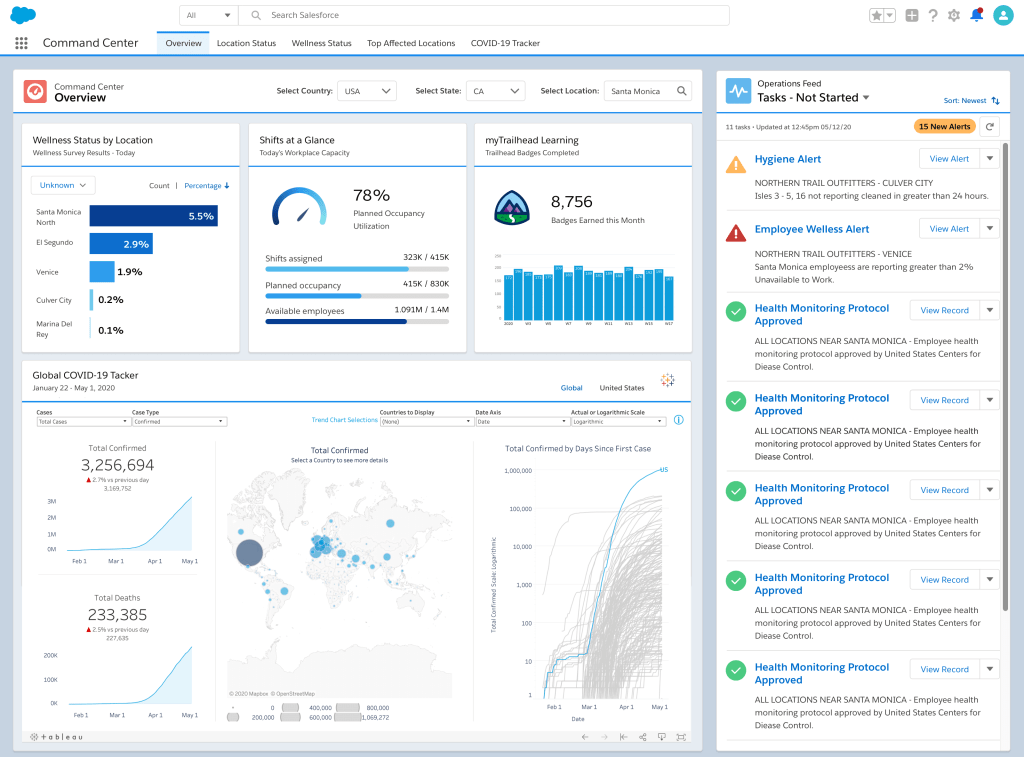At Salesforce we believe technology is a powerful tool to accelerate the private and public sector response to COVID-19. To that end, we recently released Work.com, a suite of new solutions and resources to help business and community leaders around the world reopen safely, re-skill employees and respond efficiently on the heels of the COVID-19 pandemic.
In this series, we’ll do a deeper dive into each of the Work.com capabilities: why we built the Command Center, how customers can leverage them in their response to COVID-19. This week, we’ll focus on the Work.com Workplace Command Center.

The Work.com Workplace Command Center is a single source of truth that enables organizations to get a 360-degree view of return-to-work readiness across locations, employees, and visitors, making it easy for leaders to make data-driven decisions, take action, and communicate effectively. The Workplace Command Center brings together trusted data from internal applications and employee wellness surveys, creates and disseminates important employee communications at scale, and surfaces public data through the Tableau COVID-19 data hub.
Why it matters:
We all are anxious about what getting back to work will look like. For employees, it’s wondering if our physical workspaces, fellow employees and offices will be safe. For companies, it’s ensuring that employees are welcomed back into a healthy environment. Having a single place to not only aggregate data about employee wellness, but to take action on that data, will empower organizations to get employees around the world back to the office safely—and we created the Work.com Workplace Command Center to do just that.
To learn more about the Workplace Command Center, we talked with Wade Wegner, SVP of Developer Platform at Salesforce.
Q. What are some of the challenges that companies face in their response to COVID-19 – and knowing those challengers, how did the Workplace Command Center come to be?
The first and most obvious challenge was the task of moving entire workforces to their homes. So many of us are used to working on-site, whether that be in an office building, a manufacturing floor, a restaurant, or a retail organization. Not having access to physical working spaces comes with not only the immense challenge of getting employees used to working remotely, but equipping them with the tools and resources to be successful wherever they are. People would anticipate that building a robust work from home strategy would take many years to accomplish—but all of the sudden, everyone had to do it right away.
As hard as it was for organizations to move to a remote working situation, we quickly realized that moving everyone back into the workplace on the heels of the pandemic would arguably be more difficult. Opening back up is going to require much more time, precision and thought—and it will require a lot of information in order to make choices that keep employees safe.
The Workplace Command Center was born out of the need to help executives and organizations make those informed decisions by bringing together the data they need with a tool to take action, so that everyone can put their reopening strategy into practice.
Q. Can you talk through how a company can use the Workplace Command Center?
During these times, returning to the office is personal. Even if someone is healthy, they might not feel comfortable going back right away. We built a feature called Employee Wellness Check to ensure companies can be confident that employees are physically healthy and mentally prepared enough to return to the office. The solution includes surveys and templates based on CDC guidelines to assess each employee’s health and wellness in regard to their exposure to COVID-19, and enables an organization to integrate their employee data with their back-to-work strategy. Organizations can customize these surveys within the Workplace Command Center, and see all the data by location to get a sense of what percentage of their employee population within a given office is well enough to return to the work.
When we do all return to the workplace, we’re not all going to return at once. There’s the need to drastically reduce the capacity of people who are on a given floor to accommodate for social distancing. Not to mention, obligations for many individuals have shifted as schools and childcare centers have closed, making it hard for many employees to physically come to the office every day. In order to control the flow of people into their buildings in a way that takes an individual’s needs into account, organizations will have to stagger employee schedules and arrival times— so we built Shift Management capabilities into the Workplace Command Center. This enables employees to input their availability, while organizations can identify how many people can arrive at any one time. That information is then aggregated to help schedule arrival shifts, and employees receive a mobile pass on their phones that serves as an entry pass—it’s like the Disney Fast Pass, but for offices.
We’ve built in an action framework that turns the Workplace Command Center into a place where operations leads can not only access all this important information, but they can also take action on reopening by kicking off workflows associated with reopening tasks.
Q. What was the product development process?
At Salesforce, we felt that we were well positioned to deliver solutions to our customers that will help them get through this reopening phase a little easier. An incredibly cross-functional team of product managers, engineers, UX designers, product researchers and marketers from across the organization that previously had never worked together before came together to solve this challenge. Because of the power and flexibility of our platform, as well as the determination of our team, the Workplace Command Center came together in less than two months, which is kind of mind boggling considering the scale of what we have delivered.
Q. How do our partners contribute to the Workplace Command Center? What is the role of the ecosystem?
Our partners are essential in extending the power of Salesforce, and Work.com is no exception. Three ISV partners were tapped to build Work.com solutions that integrate directly into the Workplace Command Center. Fusion Risk Management helps organizations build resilient back-to-work strategies and mitigate risk, ComplianceQuest enables companies to manage their supply chains and Traction Guest makes it possible to streamline the flow of visitors into offices. These solutions just launched within a new Work.com collection page on AppExchange—an important expansion to the AppExchange COVID-19 Resources for Businesses.
Consulting partners are also crucial to extending Work.com to our customers—organizations can connect with Global Strategic Consulting Partners like Accenture, Deloitte and PwC as they’re building their reopening strategies within the AppExchange Work.com collection page. Beyond digital transformation consulting services, these partners have developed solutions specific to combating COVID-19 and helping organizations get back to work—think contact tracing and physical distance tools integrated with Shift Management; capabilities for healthcare providers to remotely support patients; a digital office cleaning solution and more.
Q. Can you explain how Tableau and MuleSoft integrate into the Workplace Command Center?
One important source of information required to build a reopening strategy is public health information—what is the current COVID-19 status in the cities where your workplaces are located? We built the Tableau COVID-19 Data Hub right into the interface of the Workplace Command Center so that organizations can leverage this public data alongside their own business’s readiness data in order to make informed decisions about reopening.
MuleSoft is helping to integrate public data sources into the Tableau COVID-19 Data Hub through the COVID-19 Data Platform, also available as an API. MuleSoft can also be leveraged to integrate your employee data from an HRIS like Workday onto the Workplace Command Center. MuleSoft now has an Accelerator for Work.com including pre-built connectors, integration templates and data mappings to help you quickly and easily unlock critical data from systems and unleash the power of Work.com.
Q. Where do you see the most potential for the Workplace Command Center to add value to organizations?
We talked to a lot of customers about their current needs, and found that their existing reopening strategies were being built manually in spreadsheets or in Word documents. And the reality is there’s just a tremendous amount of information that must be aggregated and analyzed to make important decisions more quickly than a bunch of disparate spreadsheets will allow. The Workplace Command Center will help organizations by serving as a single source of important information and enabling them to take action to get back to the workplace fast.
At Salesforce, we believe that creating great customer experiences starts with giving employees everything they need to be successful and productive in their jobs. Ultimately, we believe that the Workplace Command Center is just the tip of the iceberg for organizations looking to provide employees with the best possible experience during this difficult time.
Q. And what did you learn throughout the process?
I was incredibly impressed with the resilience of our team, and Salesforce’s ability to identify and empathize with our customer’s needs during this really trying time. I learned that with strong resolve and determination, we can get things built quickly and deliver incredible value to our customers, our internal teams, and every single person involved in building the Workplace Command Center. The people who developed these Work.com solutions have been working day and night over the last weeks and months to get this done, and I could not be more grateful for their contributions.
Q. How is Salesforce using the Workplace Command Center to reopen safely?
We built the Workplace Command Center knowing that Salesforce would be customer zero. Salesforce always uses our own technology to deliver amazing experiences to our ecosystem of customers, partners and employees—and the Workplace Command Center is no exception. We recently used our Work.com technology to reopen our offices in Korea, Hong Kong and China, putting the Workplace Command Center and Shift Management to good use, ensuring that we have a really thoughtful and data-driven reopening strategy that keeps our employees safe. We will continue to use Work.com as we open our offices around the world.
To learn more about Workplace Command Center solutions, visit this page.

















